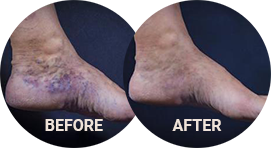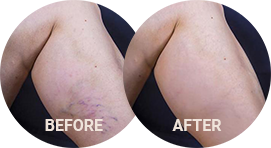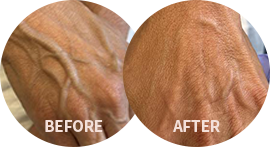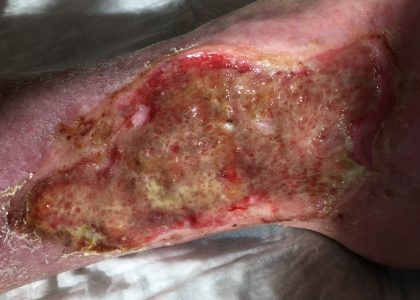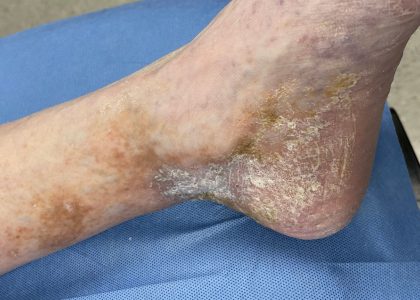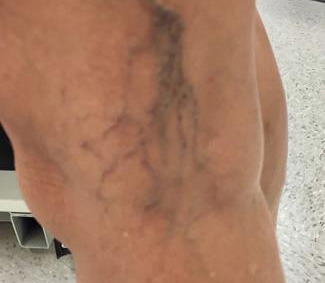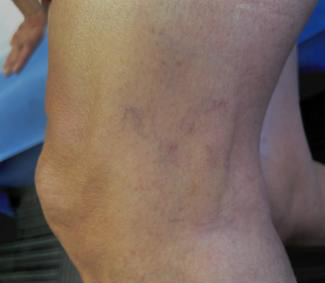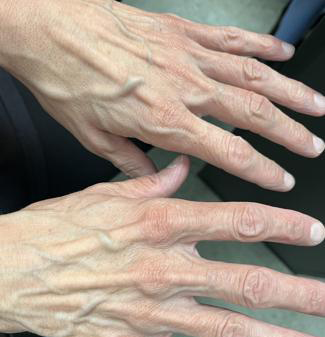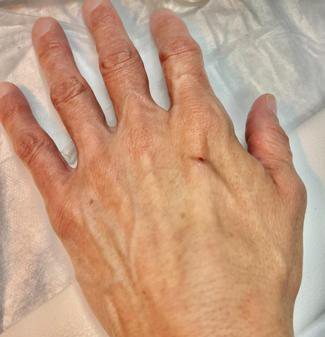Leg Swelling
Conveniently located to serve the areas of Westlake, OH
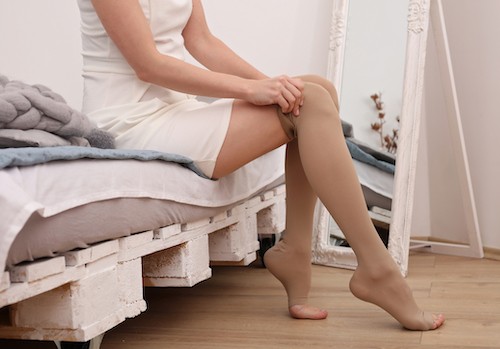
Leg swelling is a common complaint and a concern that requires prompt medical care. Swelling in the legs is associated with multiple conditions, some of which can lead to further complications, so it’s important that this symptom’s cause is properly diagnosed. Often, chronic venous disease, venous insufficiency, and/or varicose veins are what afflict patients presenting with disabling leg swelling. Leg edema, or swelling, can also be the sign of a serious heart condition, leg blood clot or a pulmonary embolism. Patients experiencing shortness of breath, chest pain, or dizziness should seek emergency care immediately.
For those that are struggling with frequently enlarged, achy legs, proper diagnosis can lead to determining the correct treatment, and ultimately ending the discomfort that this symptom causes. Vascular problems are often at the root of leg swelling, and so seeing a vein specialist is an excellent first step.
Dr. David Naar is an accomplished vascular surgeon with over 35 years of experience treating many of the conditions that cause leg swelling. Contact his offices at Premier Vein Clinic to schedule a consultation today. Your legs are trying to tell you something, and Dr. Naar can help translate. Call 440-641-0433 to reach his clinic in Westlake, OH.
Contents
- 1 Before and After Photos
- 2 Getting to the Bottom of Leg Swelling
- 3 Vein Trouble
- 4 Treating Varicose Veins
- 5 Deep Venous Thrombosis
- 6 Other Causes of Leg Swelling
- 7 Benefits of Vascular Health
- 8 Personal Consultation
- 9 What You Can Do For Healthy Legs and A Healthy Vascular System
- 10 Results
- 11 How Much Does it Cost to Treat Leg Swelling in Cleveland?
- 12 FAQ
- 13 References
Before and After Photos
Getting to the Bottom of Leg Swelling
The human body defies gravity every day. Our vascular system pushes blood upwards from our arms and legs to the heart. Our lymphatic system provides a return route for the fluid that is filtered out from plasma and blood and nourishes the other tissues in the body.(1)
However, these two systems perform a delicate dance, and when the balance of pressure in the circulatory system is altered, the lymphatic system isn’t able to keep the steady flow of fluid circulating. This causes the kidneys to react by retaining sodium and water in an attempt to compensate, which leads to an even greater presence of fluid. As a result, fluid pools in the tissue, resulting in leg swelling.
By the time you or your doctor notice swelling in the legs, you’ve accumulated at least 2.5 liters of fluid. That’s quite a bit: imagine a large bottle of soda.
There are many factors that can throw these circulatory functions off, including heart problems, which need to be addressed immediately. (2)
Vein Trouble
Although there can be many causes for leg swelling, vascular problems are the most common culprits. And, among those, the most frequent offender is chronic venous insufficiency, or (CVI). (2)
Chronic venous insufficiency is much what it sounds like: veins that just aren’t working. It’s often the result of venous reflux. When the valves in our veins become compromised, they are unable to keep blood moving upwards against the pull of gravity. Rather than the normal “traffic flow” of blood up to the heart, blood ends up pooling in the veins, creating a bottleneck effect that causes the veins to become distorted and enlarged. This is what causes varicose veins. (3)
Treating Varicose Veins
Most patients who experience varicose veins may only have cosmetic concerns. However, addressing varicose veins promptly can relieve the other unpleasant symptoms that typically accompany venous reflux.
This includes leg swelling in addition to:
- Throbbing and aching
- Cramping at night
- Restless leg syndrome, and the urge to move
- Burning and itching
When it comes to leg swelling and varicose veins, medical attention is vital. Venous reflux can often be progressive. When compromised veins are left untreated, it can then result in chronic venous insufficiency. To get started on treating your varicose veins, contact Dr. Naar to schedule a personal consultation.
Deep Venous Thrombosis
Another cause of venous insufficiency is deep venous thrombosis (DVT). DVT is a blood clot, or thrombosis, that forms in a deep vein, usually in your legs. This clot can eventually travel through the body to the lungs, where it can end up blocking your lungs. This can cause a pulmonary embolism, which can be fatal. (4)
DVT can occur at birth, result from another medical condition or injury, or occur without any known causes.
When DVT occurs alongside incompetent valves and veins, this dangerous combination can lead to increased pressure in the veins, and damage them further. This pressure can also lead to an inflammatory response in the vein. (2)
Leg swelling associated with DVT is recognizable by the following symptoms:
- Aches and pains in the legs
- Redness
- A hot sensation in the affected area
- Protruding veins
- Spider veins
- Atrophie blanche (white scar tissue)
- Lipodermatosclerosis: in which the underlying fat becomes enlarged, inflamed, and leads to the hardening of the skin
- Venous gangrene
Other Causes of Leg Swelling
Other conditions that increase venous pressure in the legs are:
- Cardiac diseases such as heart failure, pulmonary hypertension, and valvular heart disease.
- Obstructive sleep apnea
- Pulmonary hypertension due to obstructive sleep apnea (OSA)
- Kidney disorders
- Lymphatic disease
- Alcoholism
Benefits of Vascular Health
Identifying and treating the cause of your swollen legs will improve your overall health and wellbeing, in addition to providing relief from the painful, persistent swelling. And besides alerting you and your doctor to an unknown health condition, it also will allow you to avoid the many complications that can result from untreated venous reflux:
- Thrombophlebitis: painful blood clots that develop from poor blood flow
- Vein ruptures and hemorrhage
Chronic venous insufficiency can also lead to changes in the skin, known as stasis dermatitis. Stasis dermatitis can cause additional swelling and also has unpleasant and dangerous consequences, including:
- Hyperpigmentation
- Eczema
- Lipodermatosclerosis
- Stasis ulceration: the development of painful ulcers on the surface of the skin that can become infection, affect mobility and require amputation (5)
Personal Consultation
At Premier Vein Clinic, Dr. Naar can assess you for underlying vascular issues or identify other medical conditions that can cause leg swelling. Identifying the cause of your swollen legs won’t just improve your comfort; it could save your life.
Depending on the cause of your swollen legs, Dr. Naar may recommend medication, endovenous ablation, sclerotherapy, or a comprehensive treatment for deep vein thrombosis. He may choose to order lab work to check on the functions of your other organs or conduct an ultrasound to examine areas of your circulatory system. Other diagnostic services may be required, like an EKG to rule out cardiac disease.
Dr. Naar will review your medical history, examine your legs, and discuss lifestyle changes that can improve your health. To learn more about the other vascular issues that Dr. Naar treats, follow his blog.
What You Can Do For Healthy Legs and A Healthy Vascular System
Seeking medical attention for leg swelling is key. In the meantime, you can improve your comfort by taking the following steps:
- Stay hydrated
- Move your legs as much as possible, unless movement becomes painful
- Wear properly fitting compression socks
- Stop smoking
- Avoid salt
- Take an over the counter pain medication
- Elevate your legs
Results
Because leg swelling is a symptom of another underlying condition, your treatment will work to address the cause. After a successful treatment at Premier Vein Clinic, your legs will return to their former shapely selves, and you’ll enjoy the peace of mind knowing that you’ve been proactive about your health.
How Much Does it Cost to Treat Leg Swelling in Cleveland?
The cost of your treatment will depend on the underlying cause of your leg swelling. It will also include the testing necessary to determine the nature of the condition.
Click here to schedule your consultation with Dr. Naar, or call now at (440) 641-0433.
FAQ
Why is my leg swollen?
One of the most common causes of swollen legs is compromised vascular health. Changes in pressure in the blood vessels can lead to the retention of fluid in the legs. However, swollen legs can also be a sign of kidney disorders, cardiac failure, deep vein thrombosis, and obstructive sleep apnea.
Is venous reflux dangerous?
It can be. Treating varicose veins in a timely manner can avoid a host of other venous complications. Procedures like sclerotherapy and endovenous vein ablation “shut down” the deficient vein and re-routes blood to other healthier veins.
References
- Breslin JW, Yang Y, Scallan JP, Sweat RS, Adderley SP, Murfee WL. Lymphatic Vessel Network Structure and Physiology. Compr Physiol. 2018;9(1):207-299. Published 2018 Dec 13. doi:10.1002/cphy.c180015
- Simon, Elizabeth B. “Leg Edema Assessment and Management.” Medsurg Nursing: Official Journal of the Academy of Medical-Surgical Nurses, vol. 23, no. 1, 1 Jan. 2014, pp. 44–53, pubmed.ncbi.nlm.nih.gov/24707668/.
- Guo L, Huang R, Zhao D, et al. Long-term efficacy of different procedures for treatment of varicose veins: A network meta-analysis. Medicine (Baltimore). 2019;98(7):e14495. doi:10.1097/MD.0000000000014495
- Qu SW, Cong YX, Wang PF, et al. Deep Vein Thrombosis in the Uninjured Lower Extremity: A Retrospective Study of 1454 Patients With Lower Extremity Fractures. Clin Appl Thromb Hemost. 2021;27:1076029620986862. doi:10.1177/1076029620986862
- Medical Advisory Secretariat. Endovascular Radiofrequency Ablation for Varicose Veins. Ontario Health Technology Assessment Series. 2011;11(1):1-93. Accessed May 4, 2021. https://www.ncbi.nlm.nih.gov/pmc/articles/PMC3377553/


